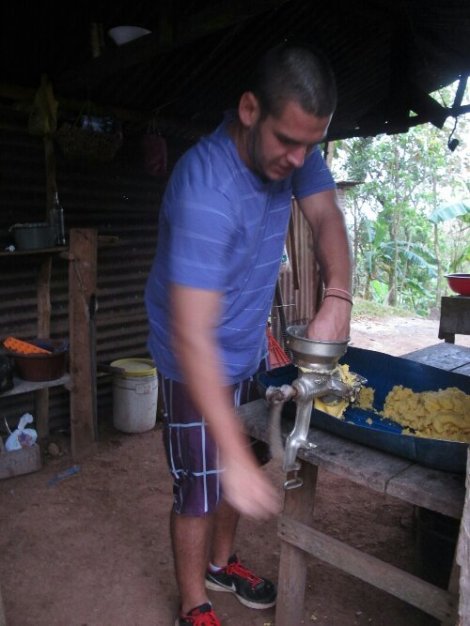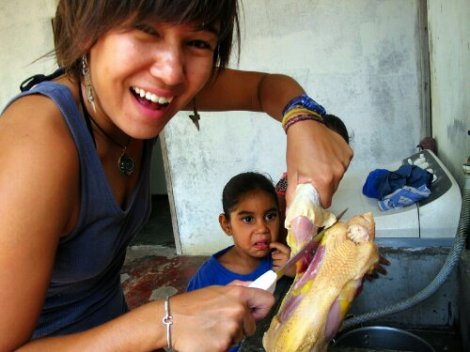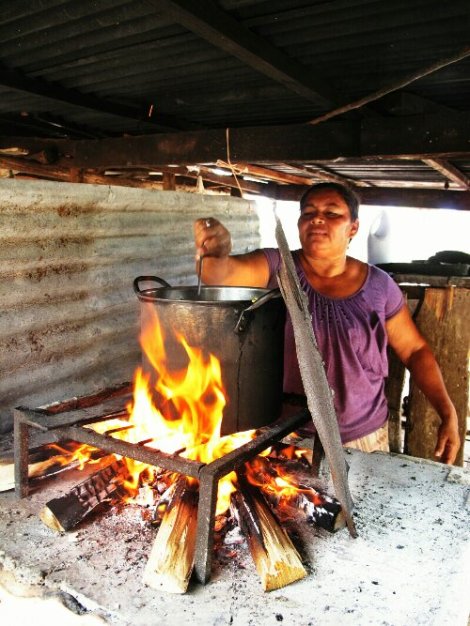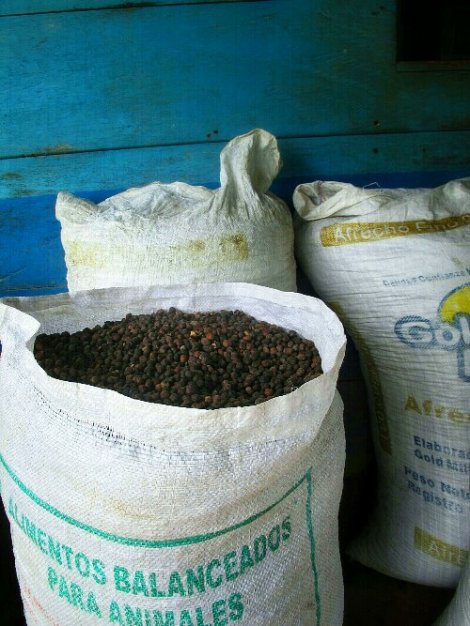Typical Comida in Panama
1. Corn. So much corn. Corn is used for bollo, tamales, empanadas, tortillas, and to feed chickens so ultimately corn is in every Panamanian meal. Families buy large bags of corn and soak them in enormous pots overnight. The following morning, they set up an old-fashioned metal hand-grinder that they proceed to stuff the corn into and turn out massive amounts of wet corny paste. This paste is then folded and beaten like dough to get rid of all the air pockets, and then it can be squeezed and beaten into whatever form you prefer. Log? Hockey puck? How about a brick of native gold? John Smith-approved.
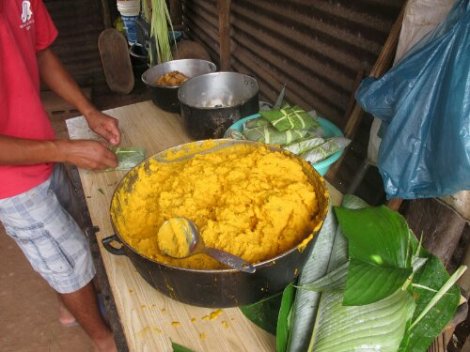
My host brother Xavier making tamales- a mashed mix of onions, culantro, spices, and chicken parts wrapped in a banana leaf and tied with palm frond into a neat little package.
2. Rice. Here rice is almost always white bleached grain that gets poured out into a bowl and scrutinized for grains with the husks or other non-rice things that were packaged in the bag. Once that process is complete, the rice is poured into a large metal cauldron and put on an outdoor stove called a fugon which is usually three stones with logs in the middle and a metal rebar grate placed across the stones or concrete blocks. ice is eaten even more often than corn, usually featured with every meal. A family will make an enormous cauldron of rice and then set it aside with a cover and continue to eat it for days. This same pot of rice may be restocked with freshly-boiled rice throughout the week. Ever eaten spaghetti with a place of rice on the side? How about a bowl of soup and a place of rice? Or hotdog and rice? Speaking of hotdogs…
3. Hotdogs. Another of the top most-commonly consumed foods. This is a typical breakfast food. The hotdog is cut lengthwise and fried in oil. Though hotdog buns are another common breakfast item, the two are rarely featured together. The buns are used for grilled cheese. Why would you put a “hotdog” on a “hotdog” bun? That’s silly.
4. Sancocho. This very traditional and delicious soup is most famous in the Azuero Peninsula. The typical sancocho is cooked with patio chicken that you kill and prepare before preparing the soup. Onions, culantro, spices, peppers, and most often yucca or ñame (two starchy potato-like verduras). Many Panamaños prefer picante or hot sauce in their sopa, so don’t listen to the fools who say Panama food is bland.
5. Hojaldras. (“O-hal-dras”)This is akin to elephant ears. Flour, baking powder/yeast (lumped into one category called “levadura”), salt, and water make up the dough, and this is roughly folded and flattened. Chunks are then torn off and thrown into a pot of hot oil. They puff up and have a crisp crust with a moist fluffy interior. The levadura gives it air pockets as the dough cooks. This is eaten for breakfast, usually with stewed salchicha in a thin tomato sauce.
6. Patacones. I.E. fried, fried platanos. Take a green platano, banana’s giant’s-blood cousin, and chop it into inch-long chunks. Drop these into hot oil and deep-fry until they’re hard and golden brown. Remove them from the hot oil, salt them, and then squash them flat on their crispy faces. When you have your steamy sticky discs, toss ’em in the hot oil for another round and remove them before they get too brown. Best enjoyed with ketchup. Better than french fries.
7. Ceviche. Shrimp, lobster, crab, clam- all types of seafood. Mixed with vinegar, celery, lime or lemon juice, and all kinds of other yummies. Everyone’s ceviche is different and a lot of cevicherias take pride in their unique recipe and quality ingredients. You can buy ceviche from the fish market in Casco Viejo in Panama City, from a restaurant, or from the guy pulling along the little cooler of plastic sauce containers of his latest batch.
8. Chicha. Chicha is another word for juice. There are tons of fresh fruits growing all over panama. Chicha flavors include orange, cantelope, watermelon, pineapple, mango, grapefruit, marañon, soursop, passionfruit, guava, and coconut. There is also typically 5x more sugar in a cup of chicha here than in the United States. The PTA would have a seizure over how much sugar there is in the chicha. There is also a rice, corn, and milk chicha with spices that is something like runny oatmeal. Which brings me to my next delicacy.
9. Crema. This is a super-rich, fortified superfood that is provided by the ministry of education to every public school across the country (when they can, heat permitting). Crema is like oatmeal, but it’s much runnier and has about 200x the amount of sugar. It arrives dry in enormous canisters that look like bomb shelter provisions. Heat it up in some whole milk, add sugar, and enjoy. When I first was given a cup of crema, I thought it might be like butter for the table. I imagined they might say something like, silly gringa, she ate the whole cup of butter. Despite the voice in my head screeching “diabetes!”, I went for it, and was rewarded with more. Joy.
10. Espaghetti or macaroni. Yup, you guessed it. Spaghetti noodles. These are slathered in foil-packet-packaged tomato paste and water. Served with rice.
11. Coffee. Panameños love their brew. But they don’t usually use the fancy electronic brewers or the stovetop espresso drips. They have a big pot of grinds they may reuse for days, and they will boil water with the grinds and just spoon it out. The end of the pot is usually a dark sludge. Burned is the most common flavor. Overextraction is a norm. And they always brew with sugar. I once made the mistake of adding a spoonful of sugar and drinking melted candy.
12. Arroz con Pollo. This is the party food. Easy to make enormous quantities of it, relatively cheap, and quick to prepare (considering it can feed well over 50 people). Step1. Cut up a ton onions, carrots, celery, and whatever other veggie you have on hand. Add garlic and culantro and spices. Cook the chicken in a giant cauldron on the fugon. Stew it in its juices. Stew it until it turns orange from all the seasonings you’ve thrown into its juices. Then dump the veggies in with the chicken and cook a bit more. Set aside and make another cauldron of rice with the same bright orange seasonings. Cover with banana leaves to keep hot. Mix in chicken and veggies and enjoy. For every large community event, there is arroz con pollo. And it is always delicious.
13. Chicharones. Imagine a pig, gutted and filleted. This is a common sight in front of carnecerias and tiendas. They shave off the fat into long ribbons and chop up the skin, then throw these chunks into a boiling cauldron of hot oil where they deep fry the fat into a saturated, variably crispy-to-rock-hard chunk of break-your-teeth-and-fill-your-mouth-with-grease goodness (or horror, depending on your taste). I personally gagged when my teeth crunched through the rocky skin to the sponge-like fat inside, bursting with retained oil and melted fats. Definitely horror.
14. Miel This means honey in Spanish, but it also means syrup from cane sugar. Miel is made with a trapiche, or a small mill that is turned by a horse or donkey. The operator pushes the long sugar cane through a hole and the mill stone crushes it and squeezes out the syrupy golden sugar into a huge tub. Miel is used for a variety of desserts, coffee, and even a concentrated beverage that is essentially pure sugar.

